The stool of the NKVD chief was very hot - Jagoda and Yezhov lasted it for only two years. Then came the execution. The Soviet Himmler, a sadist who loves to torture prisoners in person, a poison lover and psychopathic rapist - Lavrenty Beria - managed to keep him in the saddle for fifteen years.
The years 1937-1938. The Great Terror shakes the foundations of Stalin's empire. The Bolshevik apparatus is terrified by the scale and irrationality of the repression - literally no one, not even the old, distinguished communists, can feel safe. Gensek subconsciously senses that this time even he has exaggerated. The animal fear of party comrades drives the opposition to his rule, and war is also approaching. Something needs to be changed.
First of all, find a scapegoat, secondly, bet on new people. Stalin's favorite is his compatriot, Georgian Lavrenty Beria. The chief hopes that the upstart from the provinces, without contacts in Moscow, will be completely dependent on him. History will show how wrong he was.
Murder the author, make his book your own
Beria won Stalin's favor three years earlier by commissioning the rector of the University of Tbilisi to write the history of the Bolshevik movement in the Caucasus. When the work was finished, Beria made appropriate corrections to emphasize the decisive role of Stalin in the victory of the revolution, then shot the author of the study and published the book under his own name.
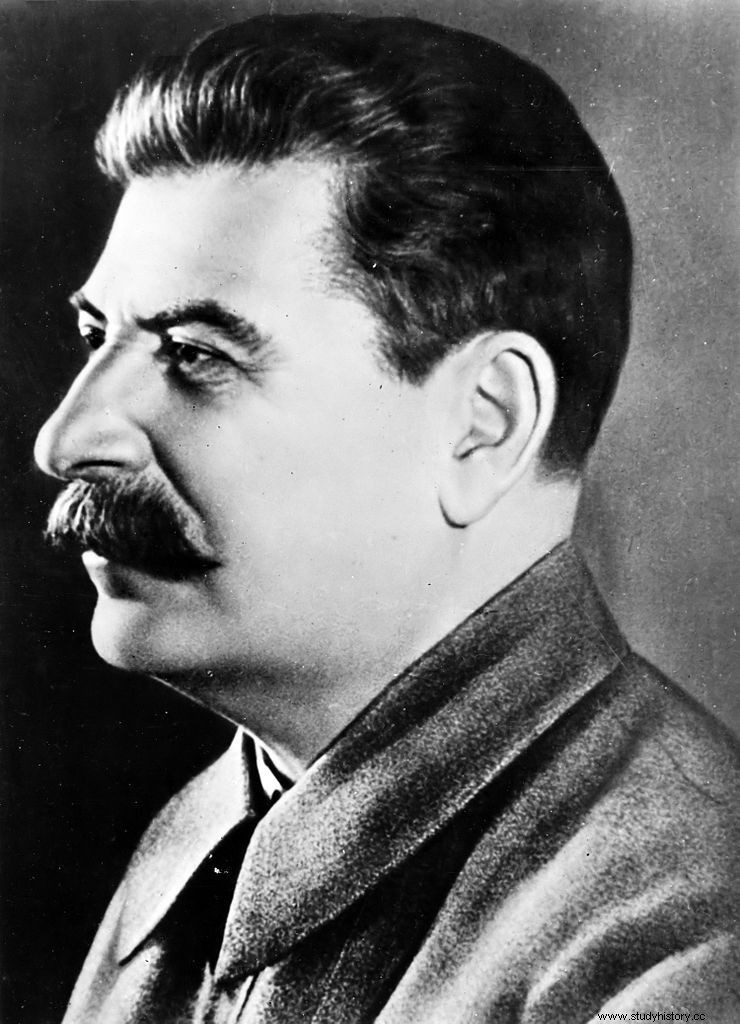
Lavrenty Beria won the favor of Joseph Stalin by ensuring the creation of a laudatory biography of the Soviet dictator (source:public domain).
Interestingly, Beria was really involved in the creation of the publication - he participated in the study of archival materials, talked, or rather, interviewed witnesses. All this to better understand Stalin. Beria's son recalls :
My father began to study Stalin's character and behavior; having an analytical mind, he grasped some features of his psychology even before he got to know it. He began to try to anticipate his reactions and identify what he was paying attention to .
The second reason for Beria's interest in the biography of the great leader was very prosaic. There was a unique opportunity to compile compromising facts and documents from the dictator's youth that could be useful later.
Three gay lovers plan to murder Stalin
Beria's first decision after joining the NKVD will be to draw up a kind of audit, an inventory of all crimes so far - to take responsibility only for those that he commits himself (there must be order in the papers). It will also be the basis for the show trial of Yezhov, who is to be the only one guilty of the Great Terror, hence the term "Yezhovshchyna" is beginning to appear in the propaganda circulation.
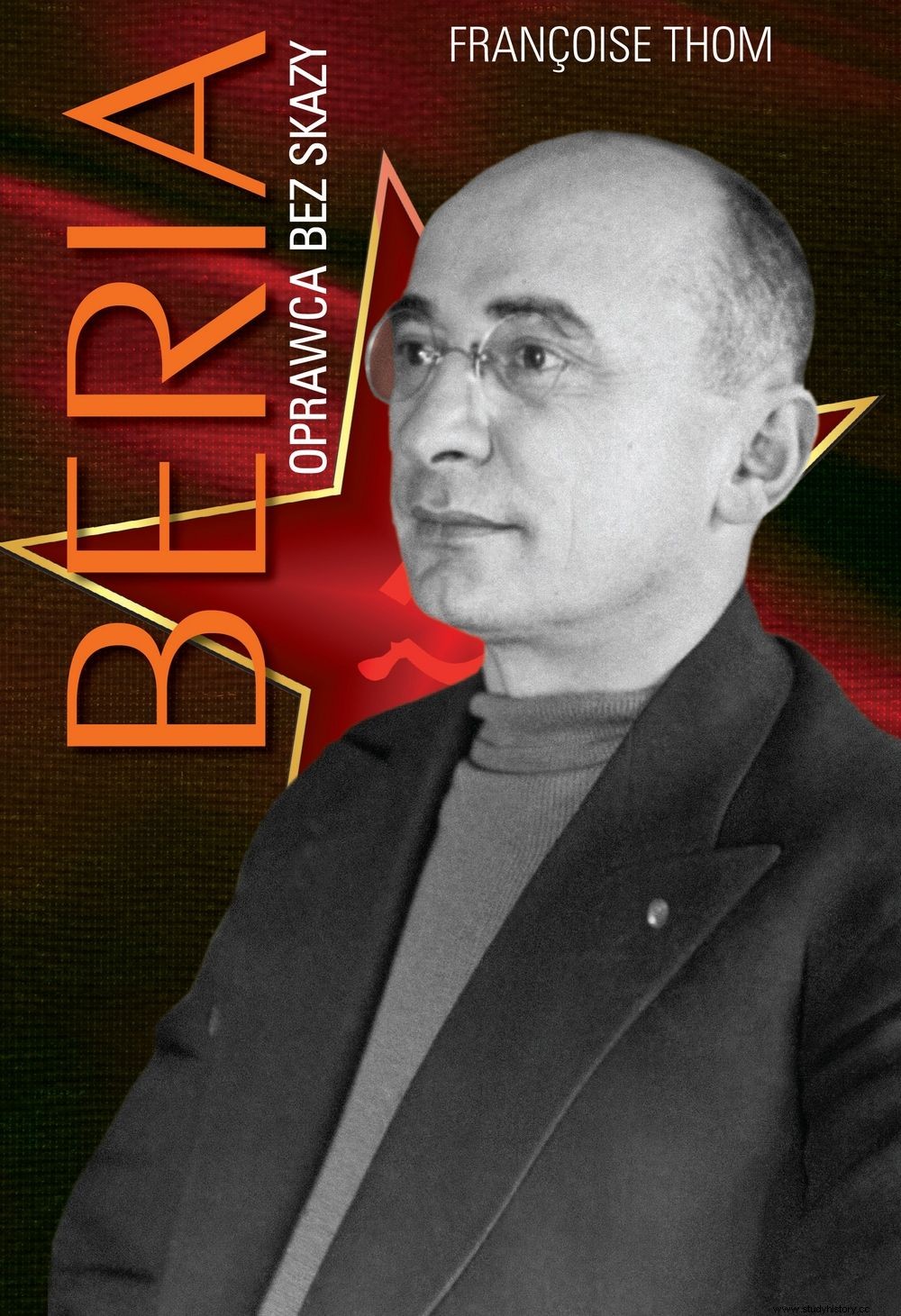
The investigation of Yezhov proves that Lavrenty Beria is an incomparable director. The previous head of the NKVD, nicknamed the "bloody dwarf", admits to espionage for Germany, Poland, England and Japan. To employ hundreds of enemy agents in the NKVD to arrest, torture and shoot faithful communists. And even to release real criminals from the camps in order to harm the Soviet power.
Novelty and curiosity in the trial at this level - Yezhov admits to homosexual inclinations, and even to the fact that, together with two lovers, he planned to murder Stalin. Soon he will be shot and the entire party apparatus will breathe a sigh of relief.
The intelligent and cynical Beria thus sends a strong message to other centers of Soviet power. As Françoise Thom writes in Beria's latest biography:
He was able to avoid the mistakes of his predecessors Jagoda and Jeżow. These two were alienated from the heads of the government apparatus, interfering in the affairs of major ministries - under the pretext of hunting corrupt officials or spying spy nests. Beria turned out to be an advocate of some form of government solidarity from the outset, and preferred to develop discrete networks of influence in these ministries rather than purges - for which his colleagues were grateful.
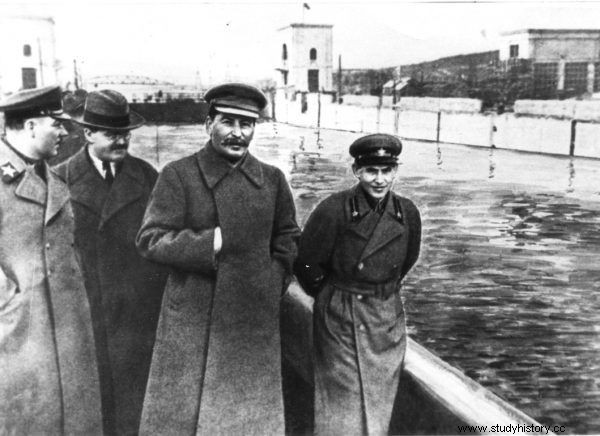
One of Beria's first victims as the head of the Soviet security services was his predecessor, Nikolai Yezhov (first from the right). After he was shot, he will disappear from this photo (source:public domain).
Of course, the repression apparatus continues to function, only in a slightly more methodical, organized way, characterized by, for example, greater finesse in the use of torture. There is a secret laboratory in Lubyanka, the apple of Beria's eye, where scientists from the NKVD prepare and test deadly poisons on people. Beria himself prides himself on the effectiveness of his investigative methods: Give me any man for one night and he will admit that he is the king of England. The Gulag system is functioning at full capacity - while in the 1930s one million prisoners were in the camps at the same time, during Beria's term this number grows to 2.5 million.
Deportations and massacres during the war
Beria compensates for some calming down in the party's internal politics on the international level. War breaks out, completely new possibilities open up. Even before the invasion of Soviet troops on the Eastern Borderlands, Beria issues orders for action to the People's Commissariat of Internal Affairs - all Poles are guilty of destabilizing the order are to be shot without trial.
This article has more than one page. Please select another one below to continue reading.Attention! You are not on the first page of the article. If you want to read from the beginning click here.
Several hundred thousand Kresowiaks are destined for deportation - representatives of the broadly understood "elite", with the Soviets including, for example, railroad workers or people collecting postage stamps. In March 1940, the head of the NKVD presented the Politburo with a motion to shoot a group of thousands of Polish state functionaries, which would become the basis of the Katyn massacre. Although in this case Beria is more faithful to Stalin's directives than to acting on his own initiative.
In June 1941, the Soviet Union invades Nazi Germany. The pace of the offensive is so unimaginable that Beria panics. The enemies of the system cannot be allowed to fall into German hands. In dozens of prisons, Soviet torturers gather prisoners in courtyards and squares, and then massacre them from above with machine gun fire. In this way, 3,500 prisoners are killed in Lviv alone, and even tens of thousands in total.
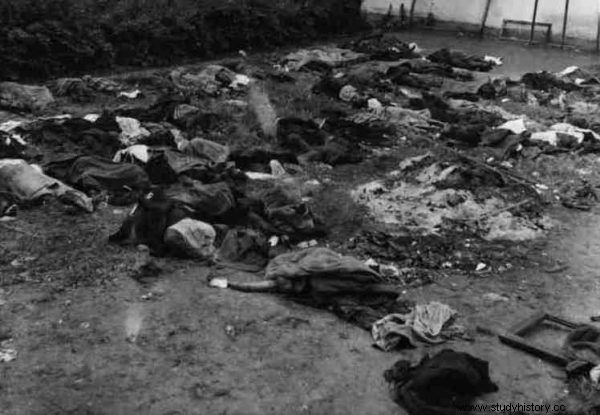
The NKVD troops retreating from the Germans murdered tens of thousands of inmates. The photo shows the bodies of the victims in the yard of the prison on Łąckiego Street in Lviv (source:public domain).
One Million Victims of Back-Shooting Their Own Soldiers
In view of the unimaginable level of defeatism of the Soviet soldiers, Stalin orders Beria to take radical measures. The latter issues the famous directive 169 on the merciless crackdown on panikers, cowards, deserters who weaken combat power and discredit the Red Army . From now on, special NKVD barrage units will fire at their own troops retreating. A shocked Wehrmacht officer recalls:
The attacking waves of the Russians pour out of the depression. Our machine guns cut them like grain. You just can't miss! They fall over like bowling pins, by the hundreds. Successive rows begin to sneak backwards. Then, somewhere behind them, machine guns crackle and they load long bursts into the back of this mass, mowing their own men! The Politicians sat in the back with their barrage troops and shot madly at the retreating crowds. The exhausted mass of people turns blindly, rushes towards us in a frantic run. And again hundreds of them are falling.
It is estimated that these bestial motivational methods cost the lives of one million Soviet soldiers during the war ...

Despite the absolute priority of the Red Army when it comes to the use of tracks and railway depots, Beria continues with the deportations of small nations. 600,000 Chechens and Ingush are deported to Central Asia, where nothing has been prepared for their arrival. One in four people will die in the next three years. Those who, for health reasons, do not have a chance to survive the transport, are liquidated on the spot - in only one Chechen town, several hundred sick and old people die in a burned barn.
Deportations continued after the war (until 1952). In remote areas of the USSR 150,000 Vlasovites will also be sent, i.e. members of collaborative units serving on the side of the Third Reich. Probably a similar number was simply shot, since a total of over a million USSR citizens fought for Hitler.
There are no thermometers, there will be a bomb
When, during the Yalta conference, Roosevelt asks Stalin who the inconspicuous man with glasses accompanying him is, he only waves his hand disparagingly: Ah… This is Beria, our Himmler . Beria is not present at the Potsdam conference, where Truman tells Stalin that the United States has nuclear weapons.
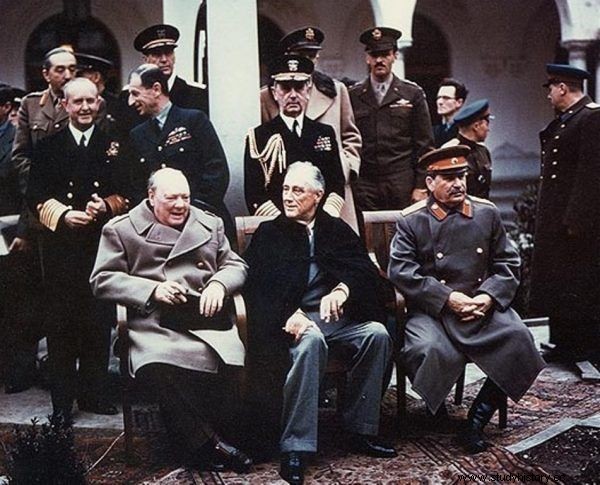
When, during the Yalta conference, Roosevelt asked Stalin who Beria was, he cynically and accurately replied that he was "our Himmler" (source:public domain).
After returning to Moscow, Stalin orders Beria, who is considered a great organizer, to mobilize all the country's resources to produce his own atomic bomb as soon as possible. How does it look in practice? Françoise Thom gives a significant example:
In the USSR you could not buy a thermometer because all the mercury available was intended for the nuclear project. And when the Minister of Health J.I. Smirnov complained about the lack of drugs in hospitals, Stalin said:"Smirnov knows about the nuclear project and should know what we are investing in ”.
By subordinating everything to the construction of the bomb, Beria once again shows his icy pragmatism. When the top of the tops tries to get the scholars working for him to join the party, he goes crazy: We won't let these bastards put sticks in our spokes. And then he adds philosophically about physicists: They must be calm. It will always be possible to shoot them later.
Buy the book on the Publisher's website:

